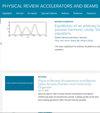Measurements and Analysis of a High-Brightness Electron Beam Collimated in a Magnetic Bunch Compressor
Physical Review Special Topics-accelerators and Beams
Pub Date : 2015-05-18
DOI:10.1103/PHYSREVSTAB.18.050702
引用次数: 15
Abstract
A collimator located in a magnetic bunch compressor of a linear accelerator driven x-ray free electron laser has many potential applications, such as the removal of horns in the current distribution, the generation of ultrashort beams, and as a diagnostic of the beam slice emittance. Collective effects, however, are a major concern in applying the technique. Systematic measurements of emittance and analysis were performed using a collimator in the first bunch compressor of the Linac Coherent Light Source (LCLS). In the nominal, undercompressed configuration using the collimator we find that the y emittance (nonbending plane) is not increased, and the x emittance (in the bending plane) is increased by about 25%, in comparison to the injector emittance. From the analysis we conclude that the parasitic effects associated with this method are dominated by coherent synchrotron radiation (CSR), which causes a “systematic error” for measuring slice emittance at the bending plane using the collimation method. In general, we find good agreement between the measurements and simulations including CSR. However, for overcompressed beams at smaller collimator gaps, an extra emittance increase is found that does not agree with 1D simulations and is not understood.高亮度电子束在磁束压缩机中准直的测量与分析
在直线加速器驱动的x射线自由电子激光器的磁束压缩器中安装准直器,在消除电流分布中的角、产生超短光束以及诊断光束片发射度等方面具有广泛的应用前景。然而,集体效应是应用该技术的一个主要问题。在直线相干光源(LCLS)的第一束压缩器中使用准直器进行了系统的发射度测量和分析。在使用准直器的标称欠压缩配置中,我们发现与注入器发射度相比,y发射度(非弯曲平面)没有增加,x发射度(弯曲平面)增加了约25%。从分析中我们得出结论,与该方法相关的寄生效应主要是由相干同步辐射(CSR)主导的,这导致使用准直方法测量弯曲面上的片发射度存在“系统误差”。总的来说,我们发现测量结果和包括CSR在内的模拟结果吻合得很好。然而,对于较小准直器间隙的过压缩光束,发现额外的发射度增加与一维模拟不一致,并且无法理解。
本文章由计算机程序翻译,如有差异,请以英文原文为准。
求助全文
约1分钟内获得全文
求助全文
来源期刊
自引率
0.00%
发文量
0
审稿时长
3-8 weeks
期刊介绍:
Physical Review Special Topics - Accelerators and Beams (PRST-AB), is a peer reviewed, purely electronic journal, distributed without charge to readers and funded by contributions from national laboratories. It covers the full range of accelerator science and technology: subsystem and component technologies, beam dynamics; accelerator applications; and design, operation, and improvement of accelerators used in science and industry. This includes accelerators for high-energy and nuclear physics, synchrotron radiation production, spallation neutron sources, medical therapy, and intense beam applications.

 求助内容:
求助内容: 应助结果提醒方式:
应助结果提醒方式:


